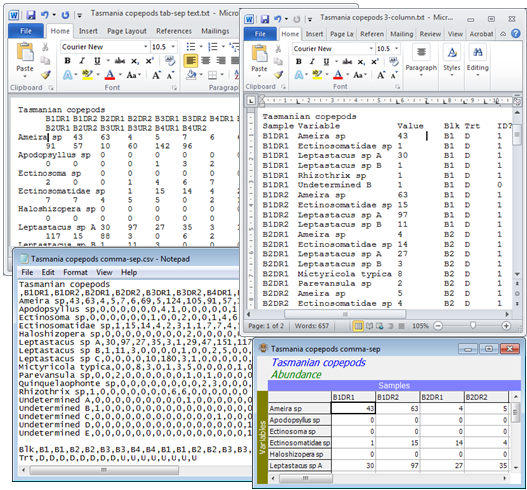Text-format input files
The Tasmania meiofauna directory also contains three different text format versions of the copepod samples, Tasmania copepods tab-sep.txt, Tasmania copepods comma-sep.csv and Tasmania copepods 3-column.txt, in addition to a fourth text version of the same data, Tasmania copepods v4.pm1, which is in the original DOS PRIMER v4 format. The first two are rectangular variables $\times$ samples (but could be samples $\times$ variables) arrays, and differing really only in what is used as a separator (delimiter) between the data entries: *.csv files are comma-separated and *.txt are typically tab-separated (e.g. outputting to *.txt format gives tab delimiters). However, input from *.txt format is more general: it can also cater for comma-separated or space-separated entries or the use of any other specified delimiter. In all cases, rows are separated by (hard) carriage returns but for columns there is no limit on the length of each line, and these will typically be wrapped (with soft carriage returns) when displayed with a text editor or word processor, as seen below. The third file, Tasmania copepods 3-column.txt, is an example of 3-column format, in which each line of the text file has only three columns of data separated by tabs (other delimiters, such as commas, are also allowed). The format must again be followed exactly: as the second line of header information shows, Column 1 is the sample label, column 2 the variable label, and column 3 the numeric data entry. The advantage of this format is that only non-zero entries need be listed – when PRIMER converts this to rectangular format the blank cells will be automatically filled with zeros (and again without fixed size limits). Importantly, this ‘flat-form’ structure is the record format which many relational databases use to hold observed occurrences or counts of a specific species at a specified location (set the third column to 1 throughout, if these are records only of presence), and the same record format is often also used for abiotic or other measurement variables. All such databases (e.g. Access) will be able to output comma/tab separated text format files of the type shown below right.

